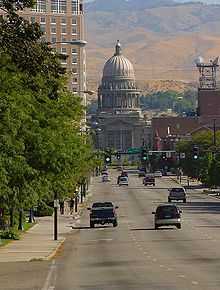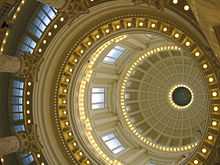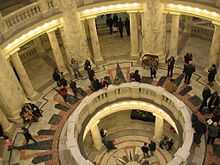Idaho State Capitol
| Idaho State Capitol | |
|---|---|
|
| |
| General information | |
| Location |
Boise, Idaho, |
| Coordinates | 43°37′04″N 116°11′59″W / 43.617698°N 116.199613°WCoordinates: 43°37′04″N 116°11′59″W / 43.617698°N 116.199613°W |
| Construction started | 1905 |
| Completed |
1912 1920 (Wings) |
| Cost | $2,098,455 |
| Owner | State of Idaho |
| Height | 208 feet (63 m) |
| Technical details | |
| Floor area | 201,720 sq ft (18,740 m2) |
| Design and construction | |
| Architect |
John E. Tourtellotte Charles Hummel |
The Idaho State Capitol, located in Boise, is the home of the government of the state of Idaho. Lewiston, Idaho briefly served as Idaho's capitol from the formation of Idaho Territory in 1863 until an act of the territorial legislature moved the capitol to Boise City on December 24, 1864.[1] A few years after Idaho gained statehood the construction on the original capitol building began in the summer of 1906. The architects who developed the building were John E. Tourtellotte and Charles Hummel. Tourtellotte was a Connecticut native whose career began in Massachusetts and skyrocketed further when he moved to Boise. Hummel was a German immigrant who partnered up with Tourtellotte in 1903 and after they finished the capitol they relocated to Portland, Oregon. The final cost of the building was approximately $2,098,455.05 and it was completed in 1920.[3] The architects used several different materials to construct the building and their architecture was inspired by various sources and cultures.[2]
Construction of the original building
.jpg)

Tourtellotte and Hummel used four different types of marble from various locations: red marble from Georgia, gray marble from Alaska, green marble from Vermont, and black marble from Italy. The architectural inspirations for the capitol’s design were Roman based, and a few examples are St. Peter’s in Rome, St. Paul's in London, and the U.S. Capitol in Washington, D.C. The most distinguishable feature to the capitol building is the dome. On top of this dome is a bronze eagle, 5 feet 7 inches (1.7 m) high. The capitol building is 208 feet (63 m) high and takes up a total of 201,720 square feet (18,740 m2), and there is over 50,000 square feet (4,600 m2) of artistically carved marble.[2] There are 219 pillars on the original building which were either Doric, Corinthian, or Ionic columns, and each pillar is made up of marble dust, plaster and scagliola. Scagliola is a mixture of granite, marble dust, gypsum and glue, and then dyed to look like marble. This mixture was created by a family of artisans from Italy.
On the first floor of the capitol building, when looking upward to the dome, thirteen large stars and forty-three smaller stars can be seen. The thirteen large stars represent the thirteen original colonies and the forty three smaller stars indicate that Idaho was the forty third state to enter the union. When looking down at the floor, a compass rose can be seen. In its center is a sundial that has minerals that are found in Idaho. Also on the first floor is a statue called “the Patriot.” It was made by Kenneth Lonn for those who worked in the mining industry.
On the second floor there are three separate entrances; from the east, the south and the west. The lieutenant governor’s office is located in the west wing, just opposite the governor’s office. On the north side of the second floor rotunda is the statue of George Washington astride a horse. And to the rear of the George Washington statue is the attorney general’s suite of offices. The offices were used by the Idaho Supreme Court until the new Supreme Court building was constructed in 1970. In the east wing is the office of the secretary of state and in the reception area is the official copy of the Great Seal of the State of Idaho.
On the third floor is where the legislative chambers are located as well as the Senate in the west wing and the House of Representatives in the east wing. The two chambers on the third floor were remodeled in 1968. Also on this floor is the Idaho Supreme Court room which is used for hearings and committee meetings of the Joint Finance and Appropriations Committee.
And lastly on the fourth floor are balcony entrances to the senate and house chambers. The balcony entrances are there so that the public can watch the legislature while it is in session. On this floor there are many historic paintings that the public can see as well as three murals by Dana Boussard. They hang in the northeast, northwest and southwest corners of this floor and the mural symbolizes the state’s diversity and unity.
Restoration of the Capitol


Back in 1998, Idaho officials created a master plan to restore The Capitol building. Though the Idaho State Capitol Building is magnificent, it had begun to fade with age. The interior restoration work would include: to restore and refinish windows, repair marble flooring, repair decorative plaster, restore wood floors, refinish wood doors and restore hardware, upgrade electrical, complete smoke and fire detection system, improve exterior lighting, add emergency power generator, and to install an accessible elevator. The legislature initially provided ($120 thousand) for the project and selected CSHQA as the developer. In 2000, The master plan was completed and it would cost a total of about $64 million.[2] They called this plan Phase I in which they expected to accomplish the exterior masonry repairs. In 2001, the legislature issued a one-time appropriation of $32 million and then would cause the government to issue bonds to the other half of the project. From 2002-2003 builders worked on Phase II of the project which involved exterior capital repairs and $1.5 million was issued to further fund the project. A few years later in 2005, a hope for the renewal of interior restoration sparked due to the cigarette tax that brought in funds to help pay for the remodel and restoration expenses that approximately totaled $20 million. From 2006-2010 authorization is given to finance two 2-story underground wings that would cost about $130 million. After the economy took a turn for the worse, Governor Otter compromised to only have two 1-story underground wings. After this compromise was reached building continued up until 2010 when both interior and exterior renovations were finished.
Scagliola
During the remodel of the capitol building, Randy Schaffer become one of the head plaster models. Randy specialized in lightweight concrete. Randy picked up the secret renaissances art of scagliola, or forming plaster to look like marble. Scagliola is a composite substance made from selenite, glue and natural pigments, imitating marble and other hard stones. Making scagliola is a laborious 15 step process which will have you starting all over with a single mistake. During its construction the Idaho state capitol’s architects used a combination of white marble and matching scagliola to create the “Capitol of Light” (the materials would literally glow in natural light into the rotunda). Randy had previously worked on the capitol on the attorney general’s office after a fire in 1992.
Capitol art
"Winged Victory": the statue is a plaster replica of the original marble statue of Nike of Samothrace. The original statue was found on the island of Samothrace, Greece in 1863 by a French explorer. The statue shows evidence of having Greek realism and dramatic features showing that is Hellenistic art. The statue was given to the United States as a gift from France after America freed France from Nazi control during World War II. The gift was chosen to reside in the Boise Capitol, and it arrived February 22, 1949.
"Statue head of Terry Shadduck": the statue head is created out of bronze and black stone. Terry was a well respected author, historian, civil servant and political activist in Idaho. Terry served the staff of several different Idaho Republicans, including several governors. In 1958 Terry was elected to position of secretary of commerce and development she was the first women ever to hold this office. The statue was created to honor and respect Terry for the dedication and passion she had towards Idaho and its politics. The statue was made out of bronze and black stone. Terry died in 2008 at the age of 92.
Attractions
Attractions in the new building consist of the Golden Statue of George Washington and information about the historic trees that surround the capitol building. The Golden Statue of George Washington was carved by Charles Osner in 1869 from white pine, which is the state tree of Idaho. He did all of his work by candlelight and it took him 4 years to finish. Another popular statue that resides next to The George Washington Statue is the Winged Victory of Samothrace which was sculpted around 350 B.C. on an island in the Aegean Sea. It was rediscovered in 1863 and Idaho received the replica in 1940 from the people of France following World War II. Next, the capitol building has many historic trees that surround the premises. Presidents Benjamin Harrison, Teddy Roosevelt and William Taft planted trees on the property; Harrison planted a Water Oak, Roosevelt planted a Sugar Maple in 1903, and Taft planted the Ohio Buckeye in 1911.
Details of the Capitol building

There are underground tunnels beneath the capitol mall connecting the Capitol Building to the Supreme Court building and other government buildings. Used daily by government employees, these tunnels are not accessible to the public, and can serve as bomb shelters to protect the Governor and other public servants. The Capitol Building also has a special parking stall next to the main entrance stairway which is reserved for the governor's personal car. His vehicle bears the Idaho license plate number 1.
The large bell directly in front of the Capitol Building is a scale replica of the Liberty Bell (uncracked). Pedestrians can ring the bell. The elevator on the east side of the rotunda could once be stopped between floors by forcing the doors open to view the walls of this elevator shaft that have been signed by hundreds of House and Senate pages over the years, as well as elected representatives. The only meeting rooms in the building where the public is never welcome are the caucus chambers and the Senators' and Representatives' lounges.
Twenty portraits of Idaho territorial and state Governors painted by artist Herbert A. Collins in 1911 are on display.
The pillars in the main lobby area are not made of marble, but are rather a notable example of scagliola.[3]
See also
Notes
Book references
- Images of America, Boise by Frank Thomason
- Boise, Idaho 1882-1910 Prosperity in Isolation by Carol Lynn MacGregor
- Historic Boise by Arthur A. Hart
External links
- Idaho Capitol Commission - History of the Idaho Capitol Building
- Office of the Governor of Idaho - Capitol Tour Guide
- Idaho Public Television - Idaho Capitol Building
- - Capitol Self Guided Tour
- - A music video shot on iPhones
![]() Media related to Idaho State Capitol at Wikimedia Commons
Media related to Idaho State Capitol at Wikimedia Commons
| ||||||||||||||||